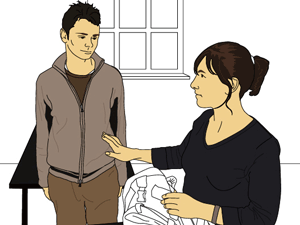|
|||
Experimenting with the Social Construction of Reality: A Game for the Autistic Mindby John Harpur, Maria Lawlor and Michael Fitzgerald Asperger Syndrome (AS) is a neurobiological disorder named for a Viennese physician, Hans Asperger. Persons with AS show marked deficiencies in social skills, have difficulties with transitions or changes and prefer sameness. They often have obsessive routines and may be preoccupied with a particular subject of interest. An assistive technology project is exploring game design and game play to deliver a social skills learning system. Asperger syndrome (AS) is an autistic spectrum disorder, characterized by social skill deficits. The Asperger Syndrome Social Education for Teenagers System (ASSETS) is a computer game-based system for developing social cognitions and skills in adolescents with AS. The content is based around interaction with social scenarios that arise commonly in adolescence. Computer game-based learning in principle offers a means for: (a) creating standardized scenarios eliminating bias (or testing for it), (b) adapting content and interactions to the actual social skill proficiency level exhibited by a subject, (c) issuing appropriate feedback to the subject, therapist, and parent, and (d) a means for maintaining a user's attention and curiosity about the subject matter. The project involves mental health professionals, computer scientists, speech and language therapist, parents and national organizations working with AS individuals. It was begun in autumn 2002. Since then work has focused on developing a social skills curriculum that could be administered by computer but also supported by existing resources (eg parents and teachers). The objective is a game-based social skills learning system defined by scenario rehearsal and a cast of eleven characters. Several of the cast are historical characters suspected of having AS. The system design is distinguished by four components. The first two are theoretical in the broad sense while the latter provide empirical input to 'power' the system. The objective is to have each character possess a set of (i) situation induced beliefs and (ii) interest induced beliefs. In addition, each character's interactions can be assessed for appropriateness by using a variation on (iii) computer adaptive testing applied to a large sample of typical teenagers. Characters can receive personality traits through (iv) a bank of psychometric tests that measure communication efficacy and self-esteem. The initial orientation of the project was based on scenario rehearsal through video modeling of problematic scenarios for those with AS and then encouraging the subjects to work through a comic book 'game' to see if they could identify a range of communication skills and their appropriateness. More recently, with additional funding, a game engine and environment is being created that will give remove many of the constraints of the prototype. In particular, video-based learning imposes tight constraints on the control logic that can be operated in 'play'. The current collection of characters is created in Maya, the 3D modeling package, and then exported to the DirectX file format. The overhead with this approach is high, as almost all properties aside from the character mesh, one colour and one texture (map) have to be engineered in the application environment. A second issue, was how large a mesh per character? Currently we fix an upper limit of 6000 polygons with back face culling enabled before export. We are fortunate in having the services of an excellent texture artist. The objective at this stage is the production of an advanced prototype for submission to a games publishing company.
Following the prototype, the structure of play is based on problem solving. In this case, the problem involves working out what to say to another character, when to say it and how to behave. It is planned to have a speech component to deal with utterances, but at present 'sayings' can be dealt with by menu. Character interactions are derived from what typical adolescents have reported of how they would interact in these circumstances. Moreover, their responses can be ranked across a number of measures. Comparing AS responses to typical responses, the system has a measure of (a) the current communicative deficits of the user, and (b) over time it can assess if they are improving. The play is driven by rewards and punishments. If a user is successful, then he picks up bonus points and can choose a recreation task. On the other hand if the user is unsuccessful, then he reverts to a lower level and has to retrain again - Snakes and Ladders. Apart from the computational tasks that must be overcome, the central pedagogical issues are two fold. Will they learn anything useful from it? Will they be motivated to return again and again? Many people with AS have normal to above average intelligence, so mastering the mechanics of play is unproblematical. However, they are not very adept at anthropomorphizing, ie attributing human like qualities to objects. Consequently, as the project rolls onward, we need to build in windows for third party inputs which will further inform the system's assessment of the user, and adjust his game play accordingly. In their simplest form these could be online questionnaires for completion by parents and teachers about the subject's social performance. This is an assistive technology project which is exploring certain aspects of game design and play to deliver a curriculum and lesson plan. Prototyping and pen-and-paper trials have been very useful and provided high quality user feedback. It will take two years before the first major evaluation is ready however. The project is supported by Enterprise Ireland, Health Research Board, Intel (Ireland), Microsoft (Ireland), Irish Autism Alliance and ASPIRE. Please contact: Maria Lawlor, St Mary's Hospital NEHB, Drogheda Co. Louth, Ireland Michael Fitzgerald, Henry Marsh Professor of Child and Adolescent Psychiatry, Trinity College Dublin |
|||



